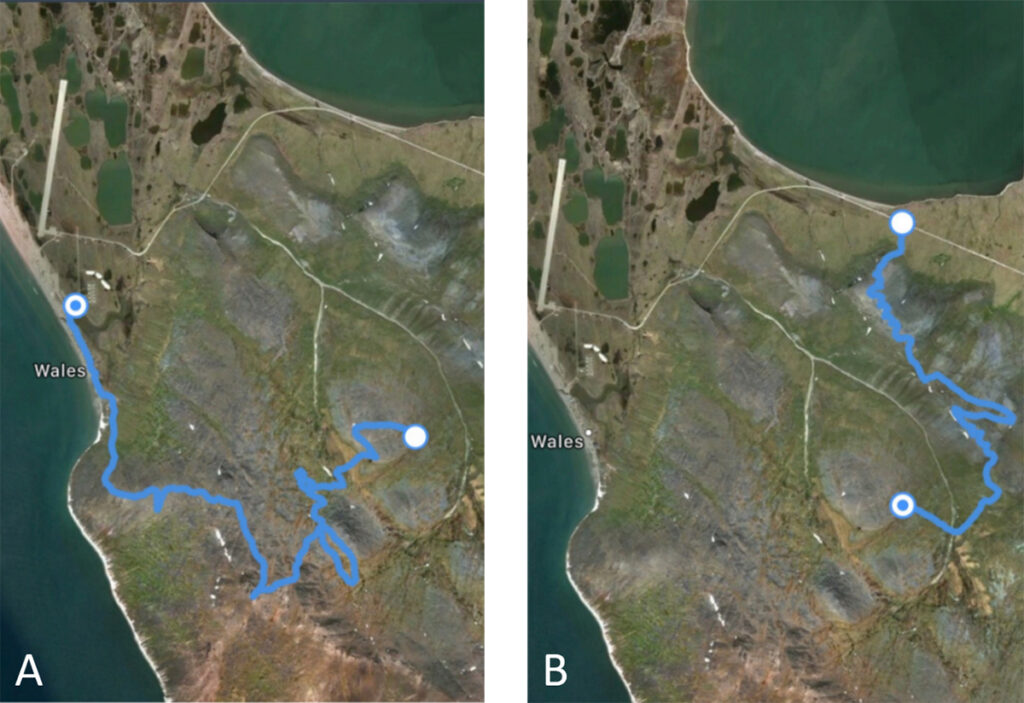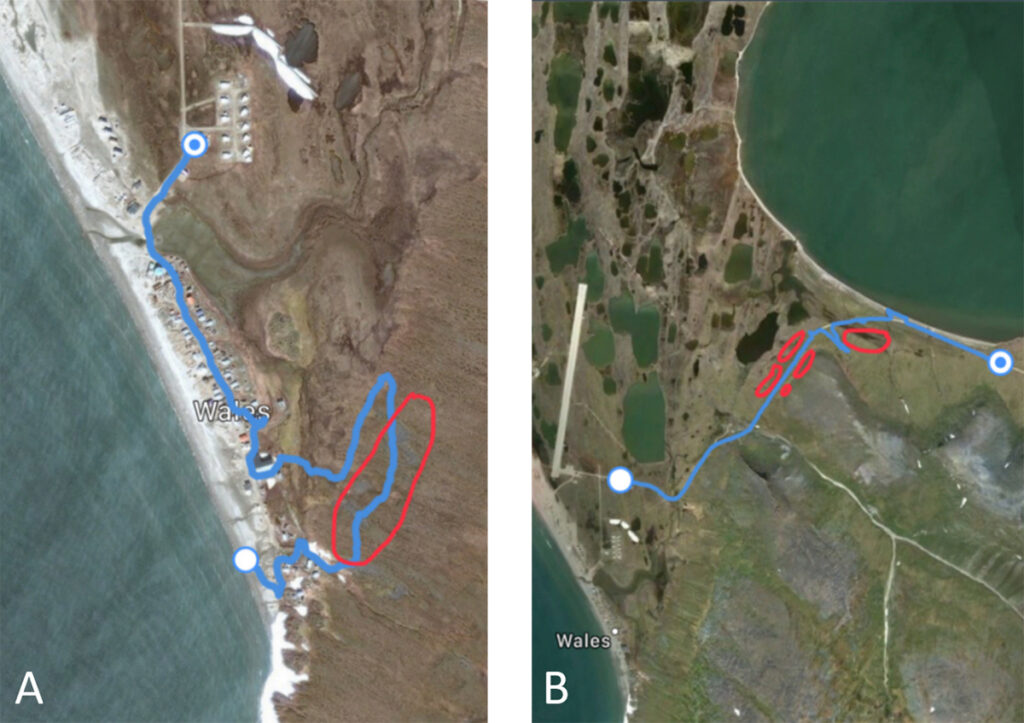Frontier eBirding - Wales 2019

Frontier eBirding – This article is part of a series illuminating eBirding trips to remote parts of Alaska with little ornithological coverage. In the United States, Alaska is unique in its size and remoteness. These combined characteristics have resulted in many parts of the state not receiving much coverage by bird watchers or ornithologists and has created gaps in our understanding of bird communities throughout the state. These articles are designed to document and encourage designated eBirding trips to remote and under-birded parts of the state to fill these knowledge gaps. Much of the state is still left to be discovered and eBirded!
Trip Summary
While the trip was short, it provides an interesting avian perspective to a site that gets very little ornithological attention. Highlights were the numerous breeding Red-throated Pipits still breeding at the site.
Previous Knowledge
Wales is a native village in western Alaska at the western tip of the Seward Peninsula. While not often visited by birders, Wales’s location provides interesting potential as birds migrate through the Bering Straight and for wayward vagrants from Asia. Ornithologically, Wales is most famous for the first North American record of Tree Pipit in June 1972, and the last know breeding locality of Eurasian Dotterel in North America. Red-throated Pipits are known to breed there to this day.
Pre-trip Logistics
Both Ravn and Bering Air have scheduled flights to Wales. Lodging in Wales is through the Indian Reorganization Act (IRA) building called “the multi-use”. Like many remote villages, a land-crossing permit is required, and can be obtained from the local Kawerak Corporation building.
Trip Account
Day 1: On 17 June 2019, I arrived into Wales from Nome around 14:00 on a Ravn Air Connect Cessna 208 Caravan. Winds were gusting to 25 knots from the north, and there was not a cloud in the sky. As we descended into Wales, I got great looks out my window of the York Mountains, Tin City, Cape Mountain, Wales, as well as King Island, Little and Big Diomede Islands and mainland Russia. Having never visited the area in the summer, it was cool to see the transition of bare gray rock (limestone I presume) in the York Mountains, to a more vegetated landscape (tundra, forbs, dark lichen-covered rocks) in the Wales area. Upon arriving, I checked in with the local Indian Reorganization Act (IRA) building, called “the multi-use” by residents. I had called ahead (907-664-3062) to reserve a room at the building and spoke with Jesse who booked me a room for the night of 17 June, at a price of $150. After paying for my room (only check or cash accepted), I made my way to the local Kawerak Corporation building (also a local grocery store) where I purchased my land-crossing permit. This permit is required if you plan to step foot off of the maintained road system. I spoke with Bill, who sold me the permit for $150. He informed me that the permit was only good for 24 hours, and another one would be required should I plan to venture off of the road system after 14:00 the next day. He also explained that the permit was instated because they had previously had issues with visitors stealing artifacts from some of the many open gravesites located on the mountainside above town.
After regrouping back at the multi-use, I headed out on a hike, with the goal of exploring as much of Cape Mountain as I could. I walked through the village and began my hike up the mountain at the southern edge of the village. I hiked from 14:30 until around 23:15, making a large loop up Cape Mountain, crossing “the valley” to a nearby ridge (just north of Cape Mountain, called “Babaq Ridge” by a local, although she did not know the exact spelling) making my way back to the Tin City road and back into town (Figures 11, 12, and 13). After reaching the second peak from the top of Cape Mountain (at around 16:20), fog began to shroud the tops of the mountain and continued to cover the higher elevations throughout the remainder of my hike. I was able to get below the fog just before reaching the road, around 21:20. Winds were light, but varying to moderate (10-15 kts) and above and below the thin layer of fog, it was clear and sunny. I logged roughly 13.5 miles hiking and covered a large portion of the north side of Cape Mountain, as well as ~3 miles of the Tin City road.

(A) Map and tracks during a walk from Wales to Cape Mountain on June 17. (B) Map and tracks from a walk from Cape Mountain to the Wales-Tin City road on June 17.
Cape Mountain Leg 1
https://ebird.org/checklist/S57503320
Cape Mountain Leg 2
https://ebird.org/checklist/S57503409
Wales (town)
https://ebird.org/checklist/S57628328
Bird abundance in the upper elevations was very low and I would go long periods without any bird detections. The majority of the northern slopes of Cape Mountain were covered in large, black, lichen covered rocks with small patches of flatter terrain covered in forbs, mosses and lichens. Babaq Ridge had much larger sections of flat terrain, but was even less vegetated with gray/white-colored limestone rock. The road was surrounded by wet tundra that was just beginning to “green up” and sprinkled with many small ponds.

A) Map and tracks from a walk around Wales birding on June 18. Red circle indicates location of three displaying Red-throated Pipits. (B) Map and tracks of birding walk back along the Wales-Tin City road. Red Circles indicate location of male Red-throated Pipits.
Day 2: On 18 June I awoke at 06:15 and made a loop through the village. It was another clear day with 10-15 knot winds from the north and a thin cloud layer covering the upper elevations of the mountain. I’ve found that mornings are a great time to explore villages because there are usually very few people awake, so I spent some time looking for passerines around buildings and the slope of the mountain directly adjacent to town (Figure 14). After exploring the village, I made it to the beach and walked ~2 miles north along the beach. At 10:13 I stopped behind a berm to shield me from the wind and spent an hour seawatching with my scope. I then looped back to town via the village dump and the airport. My flight back to Nome arrived at 12:30 and I departed on another Ravn Air Connect Cessna 208 Caravan.
Wales (town)
https://ebird.org/checklist/S57628320
Beachfront
https://ebird.org/checklist/S57628302
Airport
https://ebird.org/checklist/S57628264
Article by Nick Hajdukovich
